Los principiantes a menudo nos preguntan sobre cómo pasar sus sitios web a SSL o HTTPS. Los términos pueden sonar demasiado técnicos, pero en realidad es muy fácil de hacer.
HTTPS en la URL de un sitio web significa que utiliza un protocolo seguro de transferencia de datos mediante la instalación de un certificado SSL. Esto es importante porque la mayoría de los navegadores modernos muestran advertencias para los sitios web que no utilizan HTTPS.
Por suerte, la mayoría de las empresas de alojamiento fiables y WordPress hacen que sea muy fácil proteger su sitio web.
En este artículo, le mostraremos cómo mover su WordPress de HTTP a HTTPS añadiendo un certificado SSL. No te preocupes si no sabes lo que es SSL o HTTPS. También se lo explicaremos.
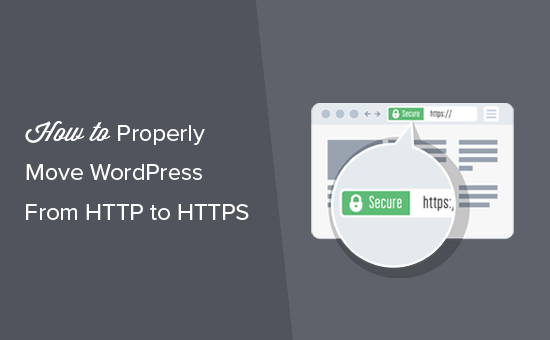
He aquí un breve resumen de los temas que trataremos en este artículo:
- What Is HTTPS?
- Why Do You Need HTTPS and SSL?
- Requirements for Using HTTPS/SSL on a WordPress Site
- Setting Up WordPress to Use SSL and HTTPS
- Method 1: Setup SSL/HTTPS in WordPress Using a Plugin
- Method 2: Set Up SSL/HTTPS in WordPress Manually
- Submit Your HTTPS Site to Google Search Console
- Bonus Resources
- Video Tutorial
¿Qué es HTTPS?
HTTPS, o HTTP seguro, es un método de encriptación que asegura la conexión entre el navegador de un usuario y su servidor. Esta seguridad añadida hace que sea mucho más difícil para los hackers interceptar los datos que se transfieren.
Todos los días, la gente comparte datos personales con sitios web, ya sea para realizar compras o simplemente para iniciar sesión. Hemos visto de primera mano lo crucial que es proteger este tipo de intercambio de datos.
Para garantizar la seguridad de los datos, es necesario establecer una conexión segura.
Aquí es donde SSL y HTTPS entran en juego.
Cada sitio web recibe un certificado SSL único para su identificación. Si un servidor intenta utilizar HTTPS sin un certificado válido o si el certificado no coincide, la mayoría de los navegadores modernos avisarán a los usuarios y les aconsejarán que no continúen.
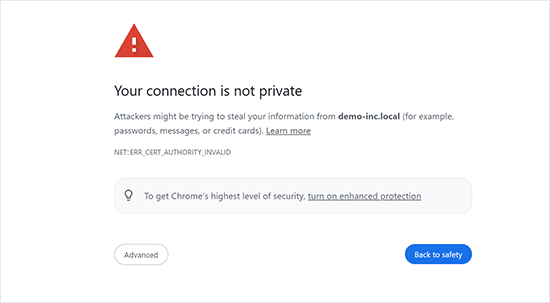
Ahora, usted podría preguntarse por qué es necesario mover su sitio de WordPress de HTTP a HTTPS, especialmente si se trata de un simple blog o sitio web de pequeñas empresas que no procesan pagos.
¿Por qué necesita HTTPS y SSL?
Ya en 2018, Google anunció una iniciativa para impulsar la seguridad web instando a los propietarios de sitios a cambiar de HTTP a HTTPS. Para apoyar este movimiento, su navegador Chrome comenzó a marcar todos los sitios web sin un certificado SSL como “No seguros”.
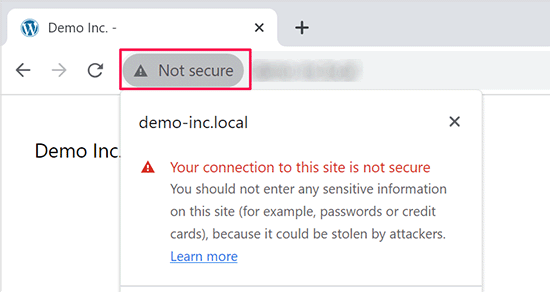
Google también mencionó que los sitios con SSL recibirían ventajas de SEO y podrían alcanzar clasificaciones de búsqueda más altas que los sitios no seguros. Este anuncio empujó a muchos propietarios de sitios a cambiar a HTTPS.
Cuando se lanzó la advertencia “No seguro”, Chrome empezó a marcar los sitios HTTP. Por ejemplo, visitar un sitio HTTP en modo incógnito o rellenar un formulario de contacto en un sitio HTTP activa la advertencia, marcándolo como inseguro.
Cuando los visitantes ven esta advertencia, pueden llevarse una impresión negativa de su sitio o negocio.
Por este motivo, todos los sitios web deben realizar la transición a HTTPS e instalar SSL lo antes posible.
Además, SSL es imprescindible si desea aceptar pagos en línea en su sitio de comercio electrónico.
Los proveedores de pago como Stripe, PayPal Pro y Authorize.Net requieren una conexión de pago segura.
Nos aseguramos de que nuestros propios sitios utilicen SSL, incluyendo WPBeginner, OptinMonster, WPForms y MonsterInsights.
Requisitos para utilizar HTTPS/SSL en un sitio de WordPress
Los requisitos para utilizar SSL en WordPress no son muy elevados. Basta con adquirir un certificado SSL, y puede que ya lo tengas de forma gratuita.
Las mejores empresas de alojamiento de WordPress ofrecen certificados SSL gratuitos a todos sus usuarios:
Para obtener más información, consulte nuestra guía sobre cómo obtener un certificado SSL gratuito para su sitio web en WordPress.
Si su empresa de alojamiento no ofrece un certificado SSL gratuito, tendrá que adquirir uno.
Recomendamos Domain.com porque ofrece la mejor oferta de certificados SSL normales y comodín.
Al comprarles un certificado SSL, también obtendrá un sello TrustLogo para su sitio web. Cada certificado SSL tiene una garantía de seguridad mínima de 10.000 dólares. Los precios empiezan en 33 $ anuales y los certificados SSL se renuevan automáticamente.
Una vez que haya adquirido un certificado SSL, deberá solicitar a su proveedor de alojamiento que se lo instale.
¿Necesita ayuda para configurar SSL y pasar a HTTPS?
Si no tiene tiempo de configurar SSL, nuestro servicioPremium WordPress Support está aquí para ayudarle. Podemos encargarnos de todo el proceso por ti, garantizando que tu sitio sea seguro y esté listo para recibir visitas.
- Tasa única
- Plazos de entrega rápidos
- Disponible 24 horas al día, 7 días a la semana
Puede estar tranquilo sabiendo que su sitio está en manos expertas. Póngase en contacto con nosotros hoy mismo para una instalación SSL y migración HTTPS sin problemas.
Establecer el uso de SSL y HTTPS en WordPress
Después de activar un certificado SSL para su nombre de dominio, tendrá que configurar WordPress para utilizar los protocolos SSL y HTTP en su sitio web.
Le mostraremos dos métodos para hacerlo, y podrá elegir el que mejor se adapte a sus necesidades.
Método 1: Configurar SSL/HTTPS en WordPress mediante un plugin
Este método es más sencillo y se recomienda a los principiantes.
En primer lugar, debe instalar y activar el plugin Really Simple SSL. Para más detalles, consulta nuestra guía paso a paso sobre cómo instalar un plugin de WordPress.
Tras la activación, debe visitar la página Configuración ” SSL. El plugin detectará automáticamente su certificado SSL y configurará su sitio WordPress para utilizar HTTPS.
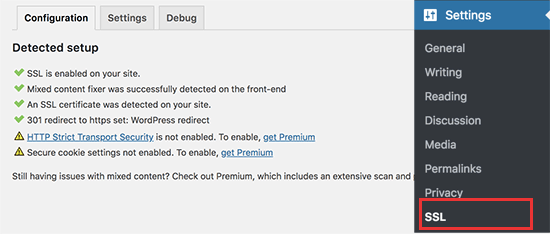
El plugin se encargará de todo, incluidos los errores de contenido mixto. Esto es lo que hace el plugin entre bastidores:
- Marcar / comprobar certificado SSL
- Establecer WordPress para usar https en URLs
- Establecer redireccionamientos de HTTP a HTTPS
- Busque URLs en su contenido que todavía se estén cargando desde fuentes HTTP inseguras e intente arreglarlas.
Nota: El plugin intenta solucionar los errores de contenido mixto utilizando una técnica de almacenamiento en búfer de salida. Esto puede tener un impacto negativo en el rendimiento, ya que reemplaza el contenido del sitio a medida que se carga la página. Este impacto sólo se ve en la primera carga de la página, y debería ser mínimo si está utilizando un plugin de almacenamiento en caché.
Aunque el plugin dice que puedes mantener SSL y desactivar el plugin de forma segura, no es 100% cierto. Tendrás que dejar el plugin activo en todo momento porque desactivarlo traerá de vuelta errores de contenido mixto. Vea nuestra revisión de Really Simple SSL para más detalles.
Método 2: Establecer SSL/HTTPS en WordPress manualmente
Este método requiere que diagnostiques los problemas manualmente y edites los archivos de WordPress. Sin embargo, es una solución permanente y de mayor rendimiento, y la estamos utilizando en WPBeginner.
Si este método le resulta difícil, debería contratar a un desarrollador de WordPress o utilizar el primer método en su lugar.
Es posible que tenga que editar el tema de WordPress y los archivos de código como parte de este método. Si no lo has hecho antes, consulta nuestra guía sobre cómo copiar y pegar fragmentos de código en WordPress.
En primer lugar, debe visitar la página Configuración ” General. Desde aquí, debe actualizar los campos de dirección URL de WordPress y del sitio sustituyendo http por https.
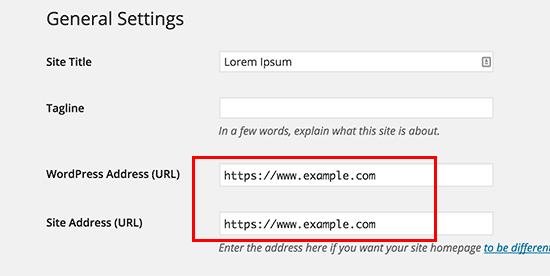
No olvides hacer clic en el botón “Guardar cambios” para establecer los ajustes.
Una vez guardados los ajustes, WordPress le desconectará y le pedirá que vuelva a conectarse.
A continuación, debe establecer los redireccionamientos de WordPress de HTTP a HTTPS añadiendo el siguiente código a su archivo .htaccess:
1 2 3 4 5 | <IfModule mod_rewrite.c>RewriteEngine OnRewriteCond %{HTTPS} offRewriteRule ^(.*)$ https://%{HTTP_HOST}%{REQUEST_URI} [L,R=301]</IfModule> |
Si utiliza servidores NGINX, tendrá que añadir el siguiente código para redirigir de HTTP a HTTPS en su archivo de configuración:
1 2 3 4 5 | server {listen 80;server_name example.com www.example.com;return 301 https://example.com$request_uri;} |
No olvide sustituir ejemplo.com por su nombre de dominio.
Siguiendo estos pasos, evitará el error de WordPress HTTPS not working porque ahora WordPress cargará todo su sitio web usando HTTPS.
Si desea forzar SSL y HTTPS en su área de administrador de WordPress o páginas de acceso, necesita configurar SSL en el archivo wp-config.php.
Añada el siguiente código encima de la línea “¡Eso es todo, deje de editar!” en su archivo wp-config.php:
1 | define('FORCE_SSL_ADMIN', true); |
Esta línea permite a WordPress forzar SSL / HTTPs en el área de administrador de WordPress. También funciona en redes multisitio de WordPress.
Una vez hecho esto, su sitio web estará totalmente establecido para utilizar SSL / HTTPS, pero seguirá encontrando errores de contenido mixto.
Estos errores son causados por fuentes (imágenes, scripts u hojas de estilos) que todavía se cargan utilizando el protocolo HTTP inseguro en las URL. Si ese es el caso, entonces no podrá ver un icono de candado seguro en la barra de direcciones de su sitio web.
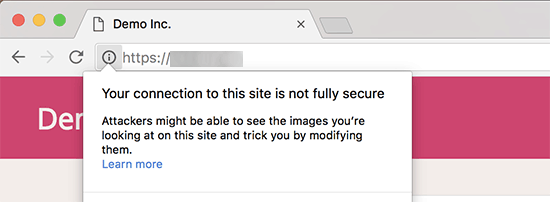
Muchos navegadores modernos bloquean automáticamente los scripts y recursos no seguros.
Es posible que vea un icono de candado pero con un aviso acerca de ello en la barra de direcciones de su navegador.
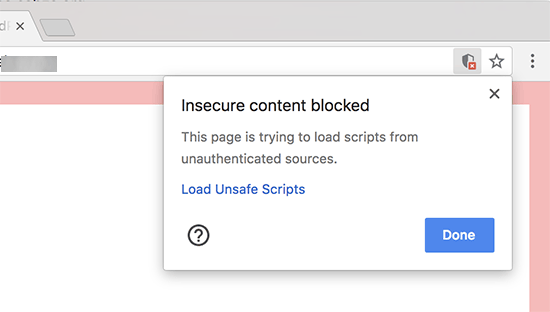
Puede averiguar qué contenidos se sirven a través de un protocolo inseguro utilizando la herramienta Inspeccionar.
El error de contenido mixto se mostrará como una advertencia en la consola con detalles para cada elemento / artículo de contenido mixto.
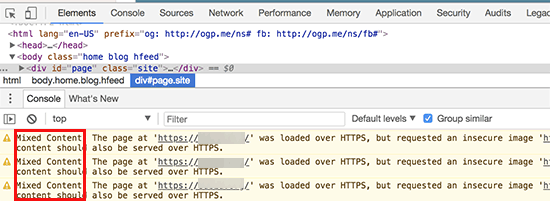
Observará que la mayoría de las URL son imágenes, iframes y galerías de imágenes, mientras que algunas son scripts y hojas de estilos cargadas por sus plugins y temas de WordPress.
Corrección de contenido mixto en la base de datos de WordPress
La mayoría de las URL incorrectas serán imágenes, archivos, incrustaciones y otros datos almacenados en la base de datos de WordPress. Vamos a corregirlos primero.
Lo mejor sería que encontrara en la base de datos todas las menciones de la URL de su antiguo sitio web que empiecen por HTTP y las sustituyera por la URL de su nuevo sitio web que empiece por HTTPS.
Puedes hacerlo fácilmente instalando y activando el plugin Search & Replace Everything. Para más detalles, consulta nuestra guía paso a paso sobre cómo instalar un plugin de WordPress.
Una vez activado, debe visitar la página Herramientas ” WP Search & Replace. En el campo ‘Buscar’, tienes que añadir la URL de tu sitio web con http. A continuación, añada la URL de su sitio web con https en el campo “Reemplazar”.
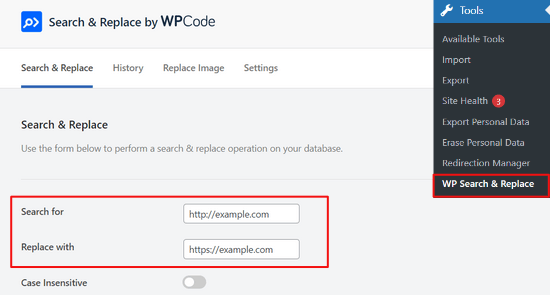
Debajo verá todas las tablas de su base de datos de WordPress.
Debe seleccionarlos todos para realizar una comprobación exhaustiva.
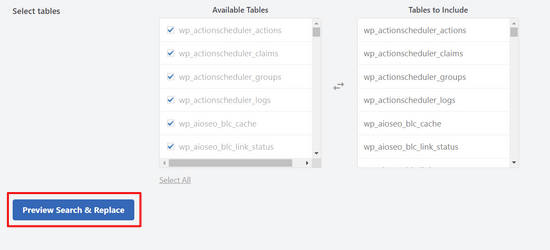
A continuación, haz clic en el botón “Vista previa de Buscar y reemplazar” para ver todos los cambios que realizará el complemento.
Por último, haga clic en el botón “Reemplazar todo”.
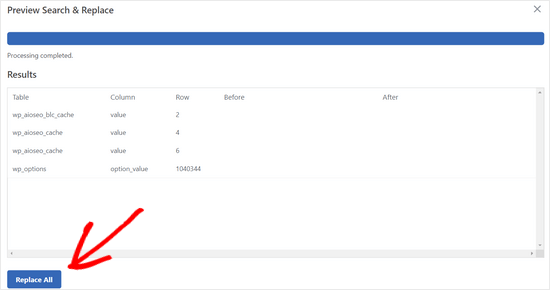
El plugin buscará en su base de datos de WordPress las URLs que empiecen por http y las sustituirá por URLs https seguras. Puede tardar un poco, dependiendo del tamaño de la base de datos de WordPress.
Corrección de errores de contenido mixto en el tema de WordPress
Otro culpable común de los errores de contenido mixto es tu tema de WordPress. Cualquier tema de WordPress decente que siga los estándares de código de WordPress no causará este problema / conflicto / incidencia.
En primer lugar, tendrá que utilizar la herramienta Inspeccionar de su navegador para encontrar los recursos y saber desde dónde se están cargando.
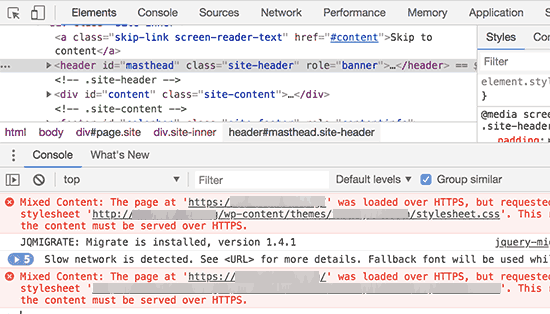
Después, tendrá que encontrarlos en su tema de WordPress y sustituirlos por https. Esto será un poco difícil para la mayoría de los principiantes, ya que no será capaz de ver qué archivos de tema contienen estas URL.
Corrección de errores de contenido mixto causados por plugins
Algunos recursos de contenido mixto serán cargados por plugins de WordPress. Cualquier plugin de WordPress que siga los estándares de código de WordPress no causará errores de contenido mixto.
No recomendamos editar los archivos de los plugins de WordPress. En su lugar, debe ponerse en contacto con el autor del plugin y hacérselo saber. Si no responden o no se ha podido corregir el problema, busque una alternativa adecuada.
Nota: Si, por alguna razón, sigue encontrando un error de contenido mixto, le recomendamos que utilice temporalmente el plugin Really Simple SSL para que sus usuarios no se vean afectados mientras corrige el problema en un sitio web de prueba o contrata a un desarrollador.
Envíe su sitio HTTPS a Google Search Console
Los motores de búsqueda como Google consideran que https y http son dos sitios web diferentes. Para evitar cualquier problema / conflicto / incidencia de SEO, deberá informar a Google de que su sitio web se ha trasladado.
Para ello, sólo tiene que acceder a su cuenta de Google Search Console y hacer clic en el botón “Añadir propiedad”.

Aparecerá una ventana emergente en la que deberá añadir la nueva dirección https de su sitio web.
Existen dos métodos de verificación de sitios: nombre de dominio o prefijo URL. Recomendamos el método del prefijo URL porque es más flexible.
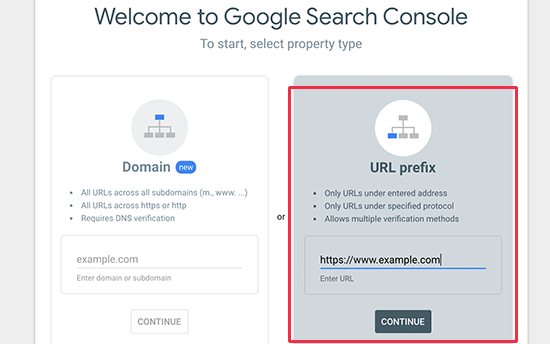
A continuación, Google le pedirá que verifique la propiedad de su sitio web.
Hay varias formas de hacerlo. Seleccione cualquier método y obtendrá instrucciones para verificar su sitio. Le recomendamos que utilice el método de etiquetas HTML.
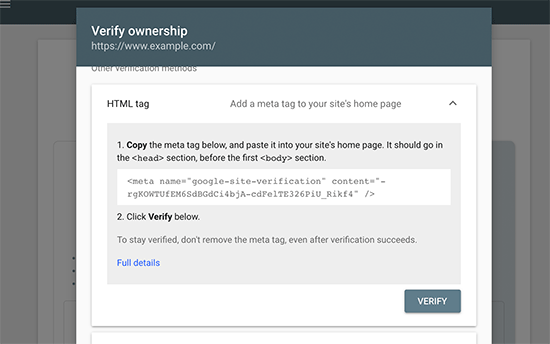
Ahora verá un fragmento de código HTML que deberá añadir a la sección encabezado de su sitio web WordPress.
Añadir código de verificación de Search Console usando All in One SEO
En primer lugar, instale y active el plugin All in One SEO para WordPress. Para más detalles, consulte nuestro tutorial sobre cómo instalar un plugin de WordPress.
Nota: También existe una versión gratuita de All in One SEO que puedes probar.
Una vez activado, ve a la página Todo en uno SEO ” Configuración general y haz clic en Google Search Console.
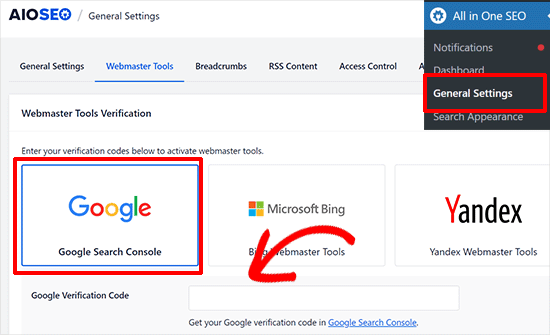
A continuación, debe añadir el código de verificación que copió anteriormente del sitio web de Google Search Console.
No olvides hacer clic en el botón “Guardar cambios” para establecer los ajustes.
A continuación, vuelve a la pestaña Google Search Console y haz clic en el botón “Verificar”.
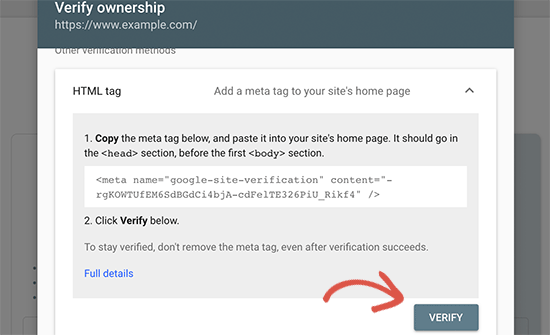
Una vez verificado su sitio, Google mostrará aquí los informes de su consola de búsqueda.
También debe asegurarse de que tanto la versión https como la http están añadidas a su Search Console.
Esto indica a Google que desea que la versión https de su sitio web sea tratada como la versión principal. Combinado con los redireccionamientos 301 configurados anteriormente, Google transferirá sus clasificaciones de búsqueda a la versión https de su sitio web, y lo más probable es que vea mejoras en sus clasificaciones de búsqueda.
Recursos adicionales
A continuación se indican algunos recursos adicionales que pueden ayudarle a solucionar problemas comunes de WordPress por su cuenta y a aprender más sobre WordPress:
- Cómo corregir problemas comunes de SSL en WordPress (Guía para principiantes)
- Los errores más comunes de WordPress y cómo corregirlos
- TLS vs SSL: ¿Qué protocolo debería utilizar para WordPress?
- Cómo corregir el error de conexión segura en WordPress
Tutorial en vídeo
Esperamos que este artículo te haya ayudado a añadir HTTPS y SSL en WordPress. Puede que también quieras ver nuestra guía definitiva de seguridad en WordPress con instrucciones paso a paso para mantener tu sitio WordPress seguro o cómo renovar tu certificado SSL.
If you liked this article, then please subscribe to our YouTube Channel for WordPress video tutorials. You can also find us on Twitter and Facebook.




Mrteesurez
This is really fantastic.
Notinhy is bad as a visitors seeing a website insecured especially an ecommerce that collect online payment from users, this is definitely a bad experience.
That’s why it’s always advisable to have https Website. Choosing one of the hostings you have listed like Bluehost and others gives free SSL and free domain for the first year.
With Bluehost, you don’t need to manually installed the SSL certificate on your website.
Thanks, sharing this.
Moinuddin Waheed
one of my clients recently purchased a shared hosting from GoDaddy and then asked to make his website.
I started making one and realised that it doesn’t come with inbuilt one click SSL installation like that of hostinger, bluehost and other hosting services providers mentioned above.
The value of having good hosting was evident when I had to go through the painstaking process of getting SSL certificate installed.
it is very advisable that one must choose good hosting service.
Moinuddin Waheed
Having https for websites is a must for securing the trust of the visitors on the website.
just curious if we have already enabled SSL for our websites, is it necessary to change everywhere from http to https?
or it will automatically take one.
WPBeginner Support
It would depend on how you enabled SSL and your hosting provider as some will automatically update your site to https while others wont. You would want to check your site to see if it was updated and if not you would need to manually update the site address.
Admin
Jiří Vaněk
It is usually necessary to manually change everything to https or use the really simple SSL plugin. If part of the site will be http and part will be https, it is called mixed content and will end up with error and problems.
THANKGOD JONATHAN
If you are beginner and do not know much about coding I recommend you use the first method.
editing your WordPress code is very risky much especially for no coders. After all, the plugin is easier to use and it also have a free version.
Moinuddin Waheed
Most of the hosting providers now a days give free ssl certificate to your site with a one click install as you have mentioned there.
having ssl certificate installed on website is of utmost importance as it gives a sense of security to the visitors and they can be sure about every thing they do on SSL certificate installed website is secure .
thank you for making a detailed description about http and https.
WPBeginner Support
You’re welcome
Admin
Nimdaqiu
I feel like I am no more a beginner now. Thank you for this beautifully detailed article.
WPBeginner Support
Glad we could help make the process simpler!
Admin
Andrew Meador
I followed Method 2. The only thing I modified was using the WordPress redirect method. My web host has a tool that creates a redirect (for Windows Server hosting) which adds redirect rules into the web.config – allowing the redirect to HTTPS to happen at the web server level vs at the WordPress level. Works good and is 1 level of abstraction higher. Thanks!
WPBeginner Support
Thanks for sharing, not all hosting providers offer that but glad your host was able to help
Admin
Clinton Waller
Thank you very much for this excellent tutorial.
I recently installed an SSL cert and was dreading the change-over with WordPress and Google. Not saying there wasn’t any pain, but your step-by-step instructions helped immensely!
Really appreciated the .htaccess code too, that’s just perfect. I was worried that Google would index both the insecure http and secure https variants of the old vs new website and give me a ranking penalty, but that trick completely avoids serving up insecure legacy http content — a real plus!
William
I have a mix of domains (all HTTPS) on my WordPress site. Can this plugin go through my site and set them all to my current domain?
WPBeginner Support
You would want to check with your hosting provider as some have tools for what it sounds like you are wanting to do.
Admin
Long
There are just no ‘WordPress Address’ and ‘Site Address’ in ‘General Settings’.
Now I use wordpress multisite, one site is https and another is http. This wordpress installation is new, I have already set https at the previous wordpress installation in my sitegroud.
WPBeginner Support
You would need to go to the network admin to change the URLs of your sites on a multisite installation.
Admin
NIKHIL
I am Using the First Method So Is There Any Need to Make Changes in WordPress and Site Address URL ??
WPBeginner Support
So long as there are no hiccups with the plugin you shouldn’t need to edit your address and URL as the plugin would handle that for you.
Admin
Stein
I followed the steps in method 2, but once I reached the step “Once the settings are saved, WordPress will log you out, and you will be asked to re-login.” instead of just logging me out it also now says that “this site is not avalible” when I try to log in to wp-admin again, making the next steps impossible to do.
So how can I access the wp-admin site following the url change?
WPBeginner Support
For that specific error, you would want to go through the troubleshooting steps in our article below:
https://www.wpbeginner.com/beginners-guide/beginners-guide-to-troubleshooting-wordpress-errors-step-by-step/
Admin
Jithin
after adding this home page is redirecting but posts not redirecting to https.
http and https .. both are working .. please help.
WPBeginner Support
Should you run into that issue, you would want to reach out to your hosting provider to ensure they do not have any redirects set up.
Admin
shantun
It helps a lot thank you
WPBeginner Support
Glad our guide was helpful
Admin
RichPat
Thank you for the SSL upgrade instructions.
Using Really Simple SSL with my hosting provided certificate was a v simple upgrade process
WPBeginner Support
Glad our guide was helpful
Admin
Michael
Thanks for your valuable content.please I want to ask,if I can use the Really simple SSL plugin which is easier,why will I want to do it manually.
WPBeginner Support
That would be mainly for personal preference, there shouldn’t be a major difference between using the plugin or manually changing it.
Admin
Jithin
Thank you for the guide.
I going to install a fresh WordPress on hostgator. Do I need to do anything different for the HTTPS ? or follow the guide after installation ?
WPBeginner Support
You can follow our guide after installing your site for enabling https.
Admin
nick Devine
Hello, I went into settings and changes http to https and now I am locked out of wordpress completely. Do you have a solution to this as it is a clients website and I am concerned I have lost everything completely. Nick
WPBeginner Support
You would want to enable an SSL certificate for the site or reach out to your hosting provider to assist you in setting the URLs back to HTTP
Admin
Oleksandr Piddubnyy
First, you need to visit Settings » General page. From here you need to update your WordPress and site URL address fields by replacing http with https.
BUT! After that my page is totally disabled! I can’t backup. I can’t even enter to the admin panel. And I don’t know what’s going on. What should I do? Do you have any idea?
WPBeginner Support
It sounds like you may have not enabled an SSL certificate on your site before changing the address. You would want to reach out to your hosting provider to enable an SSL certificate for your site or have them change your URLs back to HTTP
Admin
osama khan
Good day, thank you for the guide. I installed a fresh wordpress on a VPS with an ip addresss. Now, I want to change it to a domain name – Do I need to do anything different for the HTTPS:// ?
WPBeginner Support
You would want to check with your hosting provider for how their servers are set up for swapping to the domain.
Admin
Araceli
Hi! So it looks like, after following the steps through “Fixing Mixed Content Errors in WordPress Theme,” I see that my images are causing mixed content issues. The error I am getting is, “This content should also be served over HTTPS.” How can I fix this?
WPBeginner Support
For fixing the mixed content you would want to take a look at our article below:
https://www.wpbeginner.com/plugins/how-to-fix-the-mixed-content-error-in-wordpress-step-by-step/
Admin
Araceli
Will do…thank you!
Putri
would it be okay if I change website address and site address to https but didn’t do the rest of manual process, then install the plugin instead?
WPBeginner Support
We would recommend if you are planning on using the plugin to start with the plugin method to prevent any hiccups during the process.
Admin
Amar
Hello Sir,
I have wordpress site running on wordpress 3.5.1 . can I use really simple ssl plugin for it. The plugin says it needs wordpress 4.6 and higher.
Pls suggest me how can i do it
Thanks
WPBeginner Support
For updating your WordPress site, you would want to follow our guide below:
https://www.wpbeginner.com/beginners-guide/ultimate-guide-to-upgrade-wordpress-for-beginners-infograph/
Admin
Shawn
I am unable to access the admin login URL after updating the site URLs, it keep redirecting to https but I get a “This site can not be reached error” .. I also tried to update the .htaccess file but no luck. the original website is also not getting redirected to https.
Any ides what might I be missing here?
WPBeginner Support
You would want to first reach out to your hosting provider for them to take a look and ensure your SSL certificate doesn’t have an issue.
Admin
Lola
Thank you!
Thank you!
THANK YOU!!!
WPBeginner Support
You’re welcome
Admin
Kevin
Thank you, that Plug in Better Search and Replace made the trick!
WPBeginner Support
You’re welcome, glad our recommendation was helpful
Admin
daniel
where exactly should I place the code in the .htaccess file?
WPBeginner Support
The normal location would be beneath the current code in your htaccess file
Admin
Jessica
Inner pages and post pages are still opening with http also, which will impact on search engines. What should I do now ?
WPBeginner Support
You would likely need to clear all caching on your site and you may want to check with your hosting provider that the SSL certificate was applied correctly.
Admin
Leos
Why would you add define(‘FORCE_SSL_ADMIN’, true) to wp-config file if the .htaccess redirect rule already does the job?
When adding the line to wp-config file I got a syntax error right after and it was not possible to get to the admin area.
WPBeginner Support
The FORCE_SSL_ADMIN is for your admin area to ensure it is using HTTPS. You would want to ensure you copied the entire code correctly. If you were missing the ; it would give a syntax error.
Admin
rohan
Hello,
Thanks for the detailed guide. After switching from HTTP to HTTPS, I added the new property to Google Search Console.
Do I need to submit the sitemaps again as well on the HTTPS version in GSC?
Beginner query.
WPBeginner Support
You would want to do that for safety, yes
Admin
Celena
Thank you! Very helpful!
WPBeginner Support
You’re welcome
Admin
Phil
Better Search & replace is 1.3.3 and has not been updated for a year and is not tested on the current wordpress version. It is compatible only up to 5.2.6.
Is it safe to use, or can you recommend an alternative please?
WPBeginner Support
For those warnings, you would want to take a look at our guide below.
https://www.wpbeginner.com/opinion/should-you-install-plugins-not-tested-with-your-wordpress-version/
Admin
RomRom
Solution 2 wasn’t working for me, the website would be unavaible.
After a few attemps, I noticed my hosting provider already provides a force https option. Turn it on, and bingo.
WPBeginner Support
Glad you were able to find a solution that worked for you
Admin
Feranmi
What of if my hosting provider doesn’t support free SSL certificate can the plugin works also or how can I get it for free?
WPBeginner Support
If your current host does not offer free SSL then you would want to reach out to them for what options are available.
Admin
Yasir
Is this plugin is secured.
WPBeginner Support
Yes, the plugin should currently be secured.
Admin
ammar
Hi, if i’m using the 1st method, do I need to follow the Submit my HTTPS Site to Google Search Console step also after that?
TQ
WPBeginner Support
Yes, you would still want to follow that step
Admin
Swen
I installed the Really Simple SSL plugin, which states that you should manually replace every http:// in all .css and .js files to //. That doesn’t sound really simple to me. As a beginner I set up a simple website with a couple of pictures. Is it common that http:// statements are in these files?
WPBeginner Support
Normally those links are not common so it shouldn’t be something to worry about.
Admin
Lucas
Hi,
When adding the code to .htaccess, i get a “too many redirects” error. I tryed adding to the existing code above, below, and also erasing the existing code and using only the new. All three option get too many redirects.
Is there something I should change there? Thanks in advance for your help!
WPBeginner Support
You would want to try some of the suggestions in our article here:
https://www.wpbeginner.com/wp-tutorials/how-to-fix-error-too-many-redirects-issue-in-wordpress/
for resolving the too many redirects and should those recommendations not work, you would want to check with your hosting provider to ensure they do not have a system that needs to be modified to point to the https version of your site.
Admin
Sotir Sotirov
I’ve tried using the plugin but when I do the website becomes not accessible. I’ve tried the manual approach but once I’ve changed the addresses in WP settings the site becomes not accessible again.
WPBeginner Support
You would want to reach out to your hosting provider to ensure that your SSL certificate is connected to your domain correctly and they should be able to help
Admin
Mike Ashworth
I am about to make the change to SSL and will be following the guidance in te article, initially using the really simple ssl plugin. Before i begin i have a quick question.
If I use the really simple ssl plugin, which takes care of everything, i can leave the general settings in wordpress for wordpress address and site address as http rather than change to https as the plugin will be taking care of it?
WPBeginner Support
Correct
Admin
Mike Ashworth
Thanks for confirming. I have one other rquestion.
having just activated lets encrypt ssl on siteground for a website, i am asked wther i want to switch the following on or leave it off.
HTTPS Enforce – Forces your site to work entirely over an encrypted HTTPS connection. The redirect is performed on server level and works for any website.
Do i leave this off as the really simple ssl plugin will take care of this as well?
WPBeginner Support
Yes, you can leave that off, you would only want to use that should there be any issues with the plugin or Google finding http links
Mike Ashworth
Thanks for your advice. WP Beginner is such an awesome website. Keep up the great work!
stephan
I want to thank you a lot. I have been looking for the errors over 12hours and get it done with better replace plugins. Thanks a lot dear.
WPBeginner Support
Glad our recommendation could help you
Admin
Arlina
Does adding in the plugin of SSL slow down my blog speed performance?
WPBeginner Support
It shouldn’t slow your site down
Admin
Peter Wilson
Can someone tell me, do I replace the contents on my.htaccess. file with the suggested code or do I place it and the beginning/end of the eisting entry.
WPBeginner Support
You would add it at the end of the current code in your htaccess file.
Admin
Peter Wilson
Thanks for the quick reply. So, would that be after the existing and before the # END WordPress, or does it go after the .
WPBeginner Support
That should not matter, it may be a good idea to do it after should you need to remove the code in the future
Shivanandana
Really awesome guide. Thank you so much! Thanks again for this detailed post!
WPBeginner Support
Glad you like our content
Admin
Håkan
Great content, helped me alot!
WPBeginner Support
Thank you, glad our content was helpful
Admin
Harsha
Very useful guide, thank you very much!
WPBeginner Support
You’re welcome, glad our article was helpful
Admin
Jan-Peter Molenaar
Thanks a lot!! Valuable content
WPBeginner Support
You’re welcome, glad our content is helpful
Admin
Greg
This article was so helpful. Thank you so much! Made it very easy.
WPBeginner Support
You’re welcome, glad our article was helpful
Admin
Nel
Most helpful guide ever. Thank you for this.
WPBeginner Support
You’re welcome
Admin
Jessica Quadra
This was so helpful and each step worked perfectly. Thank you!!
WPBeginner Support
You’re welcome, glad our guide could help
Admin